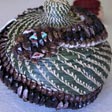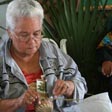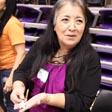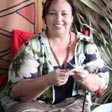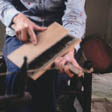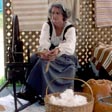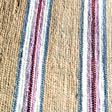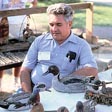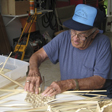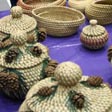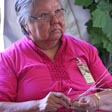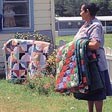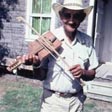España y La Louisiana
By H. F. "Pete" Gregory
Spain acquired Louisiana by means of a secret treaty with France at the end of the seven-year conflict between France and England. At that time France relinquished her North American colonies and England received all the lands east of the Mississippi River, except for the Isle of Orleans. The lands of the western Mississippi Valley were then given to Spain. Spain controlled the Louisiana colony from 1763 until it was returned to France in 1800.
In this vast territory with few European people, Spain found new challenges. Lower Louisiana—bordering the English on the east, populated by French citizens and their Indian and African slaves, and the Native American tribes aboriginal to the region—was not easily ruled. The first Spanish attempts to take control were rejected, and military rule followed. Eventually the Spanish authorities relented and left local control in the hands of French administrators, many of whom were born in the colony. Simultaneously, Spain sent the Valenciano, Francisco Bouligny, to Louisiana with new plans for the region. Spanish development of the colony was based not on trade with Native Americans, but on establishing resident populations and local development. Plantations and cattle farms began to appear, even in the back country.
Spanish culture began to fuse with French and Native American cultures, among others. To augment the region's small population, new immigrants were invited and given land grants and military garrisons to protect them. These new immigrants added multi-cultural elements as Native Americans, Canary Islanders, Spaniards, Acadians, Haitians, and Irish Catholic populations moved onto Spanish territories. Each of these groups added to a mixture of cultural items, many of which have persisted to this time, like the French, Spanish, and Native American languages that remain in Louisiana today.
Folks in the rural portions of the modern state retain and guard their languages, arts, and crafts. The French-speaking Acadians displaced by the English to the fledgling colony, the Haitians displaced by internal strife, the Canary Islanders (Isleños) brought in from their islands to strengthen Spanish culture, and the tribes of Native Americans who had been friends and allies of the French and the Spaniards east of the Mississippi River, all added their own cultural elements to the mix. Influences from West Africa, by way of slave and free black populations and already present by the 1760s, came into play as well. Even small communities of Irish Catholics with anti-British sympathies were welcomed. As life under Spanish administration changed some aspects of life, some remained the same. Spain encouraged farming, ranching and plantations. Fishermen and farmers offered their produce. A grand market developed in New Orleans which, in Spanish fashion, helped keep traditions alive.
By the 19th century, some 40 communities developed across lower Louisiana and the Gulf Coast, where these various culture groups mixed and mingled to form a blend still referred to by the Spanish term Criollo, or Creole in French. Creole refers to things, even people, produced by the New World experience. Racial mixture—White, Black, Indian and others—accompanied Spanish colonies, and a Creole population grew up around each of the older forts or garrisons.
Each group that immigrated under Spanish administration of Louisiana left communities, language enclaves, material culture and racial elements. Closer than much of North America to Spanish culture and trade, modern Louisiana continues to be a vibrant, exciting place.
Louisiana's major cities tended to develop on the locations of former Spanish administrative centers, including New Orleans and Natchitoches—virtually the only population centers prior to Spanish administration. Opelousas, St. Martinville, Alexandria, Marksville, Franklin, Vidalia, and Monroe are all cities rooted in the former Spanish posts. The government, religion, and foodways clearly reflect Spanish elements.
Recently, an exhibit was created to introduce the people of Spain to the complexities of Louisiana using a small collection of folk crafts and craftspeople whose ancestors settled in Louisiana under the colonial administration of Spain. The exhibition which went to Spain was entitled "Louisiana, Bienvenidos a Todos."
These are some of groups represented in the exhibition:
Apalachee
The Apalachee tribe, Muskogean speakers from Florida, moved from Mobile Bay in 1763 to the Red River in Spanish colonial Louisiana. Converted to Catholicism early in the French colonial era by Spanish missionaries in Florida, the Apalachee petitioned for a church and a priest as they fled the English into Spanish territory. Working as farmers, guides, and laborers in the colonial period, the tribe was displaced with the expansion of plantations in the American period (1830s). They sought refuge in the poorer pine forests and swamps a few miles west of the land grant given to them by Spain. Their descendants, intermarried with French and Spanish families and remain there today. Centered around their church and cemetery, the Apalachee are scattered in kin groups across the wooded countryside. Recognized as a sovereign nation by Spain, the tribe and its pleas for protection were ignored by the American government in the 19th century, and the group continues to struggle in its efforts to maintain identity today. Their language had been replaced by English and French, but some traditional arts and crafts have been maintained and "new" pan-tribal artistic elements are now shared with their Native American neighbors. The Apalachee continue to work as farmers and ranchers and in the timber industry, while still maintaining tribal organization and oral traditions.
Choctaw
Numbers of small bands of Choctaw Indians entered central Louisiana during Spanish colonial times. Separated from their larger tribe in Mississippi, these groups became autonomous and dealt independently with the Spanish government. North and west of the Spanish colonial outposts at El Rapids (Rapides) and at Natchitoches, these groups scattered out across the country towards Spanish Texas. The Clifton Choctaw community in Rapides Parish traces its roots back to these early bands of hunters and traders. Today, only vestiges of their native language, kinship, arts and crafts, and tribal organization serve to link them to their past. Still they maintain their autonomy as a Native American community, separate from other Choctaw communities, much as their ancestors did in Spanish colonial days. They are recognized as an American Indian community only by the state of Louisiana and themselves. Intermarried with Creoles and Anglo-Americans, the Clifton Choctaw are a unique blend of cultures. They remain in place as lumbermen, farmers, and herders. Only recently have they been reached by paved roads and integrated public schools. Cultural change comes slowly in such communities.
Houma
The Houma are a tribal group of Native Americans that moved to the bayous and marshes of southern Louisiana from Mississippi in the early Spanish colonial period. Along with members of other tribes, the Houma organized communities in the hostile environments along the Gulf of Mexico. They became fishermen and trappers, and on a more limited basis, farmers, growing maize, beans, and squash. Recognized as a sovereign tribe by Spain, they struggle to re-establish that equality with the United States. Recognized by the state of Louisiana, the Houma tribe lacks acknowledgment as an Indian tribal government by the Federal government. The marshes and bayous of lower Louisiana offered the Houma isolation and protection from their enemies, and also opened new vistas for ecological adaptation. Today, their arts and crafts traditions—based on the use of palmetto, cypress, and other local vegetation and resources—are unique among Native American tribes. French language borrowed from their Acadian neighbors and kinsmen remains the first language for most of the Houma, making them one of the strongest Francophone communities in Louisiana. Indirectly, the survival of French among the Houma is attributable to Spanish tolerance for cultural diversity in colonial Louisiana.
Acadians
The Acadians, often called Cajuns, came to Louisiana after the French and Indian War. Two major migrations occurred after the English colonial powers expelled them from their communities in eastern Canada. After some peregrinations they found solace in Spanish Louisiana where there was respect for their Latin culture, especially language and religion. The earliest Acadians settled along the west bank of the Mississippi north of New Orleans where they began to farm. Later, they and their kinsmen expanded to the prairies of Southwestern Louisiana. In spite of intense pressure to Anglicize their culture, the Acadians have remained Roman Catholic and still speak French among themselves. In the Mississippi floodplain, they became fishermen and small farmers, and in the prairies of southwestern Louisiana, they established ranches and borrowed elements of the Spanish cattle and horse traditions. Today these people maintain traditional arts, crafts, and music. However, they have also produced governors, priests, and industrialists among the famous leaders of Louisiana.
Isleños
The Spanish colonial governor, Bernardo de Galvez, saw the need for Spanish-speaking populations in the Louisiana colony, so he brought people from his native Canary Islands to the vicinity of New Orleans and into lower Louisiana. Scattered along the lower Mississippi River, the Canary Islanders, called Isleños today, were settled mainly on the higher land between the river and the coastal marsh at Delacroix Island, Ycloskey, and Reggio, where they remain. In these St. Bernard Parish communities, and along Bayou Lafourche near Thibodeaux, Louisiana, Spanish language has survived among the Canary Islands descendents. Similarly, they have maintained arts, food ways, and musical traditions that trace directly back to their Spanish roots. Borrowing a few French loan words, Spanish has remained almost pristine since colonial days. Commercial fishermen, trappers and small farmers, the Isleños remain much as they have since colonial times. Today, the communities are trying to revitalize and preserve their Hispanic heritage. With the help of the U.S. Department of Interior and Jean Lafitte National Park, the Isleños have developed a museum and cultural center—viable efforts to maintain their culture.
Koasati (also called Coushatta)
The Koasati, originally came from Alabama and migrated west, out of English territory, to Louisiana in the Spanish period. The Koasati speak a Muskogean language closely related to Creek and were neighbors to the Choctaw on the north and west. They settled on the Isle of Orleans, then moved to Red River. A large village developed north of modern Shreveport, Louisiana. The tribe eventually migrated to Spanish Texas and then, in the 1830s, to southwestern Louisiana. Today their primary community is in Allen Parish near the town of Elton, Louisiana. They retain their pre-European language, their traditional matrilineal clan kinship system, and many of their traditional arts. About 800 members are enrolled in the tribe today. They are recognized as a sovereign nation by the United States government. Tribal members farm, raise cattle, work in the petroleum industry, and in their native-owed casino. The tribe maintains a world class hotel and casino complex, as well as a crafts outlet, a community center, a court system, and a police department. Some families have Spanish surnames today, like their Chief, Lovelin Poncho. Others retain their Indian names, like Abbey, or have French surnames: Sylestine and Langley. The Koasati have kept their culture intact and could not have done so without Spanish colonial policies that allowed them to keep their tribe together. They are famous for their split cane and pine needle basketry and for their mythological stories—part of their heritage they have maintained.
Los Adaesaños
In 1719, Franciscan missionaries came from Mexico and Texas to attempt conversion of Native Americans. As the French moved towards Texas, Spanish missions were established to encourage trade between the tribes, the Spaniards, and the French. Fearful of French expansionism, Spanish authorities established a full garrison, a royal presidio, Nuestra Señora del Pilar de los Adaes, to guard the Louisiana Texas frontier (1721 – 1773). Closed after Louisiana became a Spanish territory, Adaesaño families were ordered back to Texas. Gradually they managed to return to their patria chica in northwestern Louisiana. Centered today in east Texas (Nacogdoches, Chireno, Moral) and in Sabine and Natchitoches Parish, Louisiana (Zwolle, Ebarb, and Spanish Lake) communities, their descendents represent one of the oldest Hispanic or Indo-Hispanic populations in North America.
The Creoles
The word, Creole, from the Spanish, Criollo, meaning born in the New World, has multiple meanings in Louisiana. Americans considered it to suggest mixed-race, mixed-culture folks. Race conscious French and Spanish whites used the term exclusively for themselves. Free blacks, Indians and other mixed-race people were classified as gens de couleur libre. However, these people preferred the term, Creole, and have made it their own. Today, it refers to a multi-racial and multi-cultural mixture. Some Creoles self-identify as black, others white, and some Native American, but all recognize the appellation, Creole. The Spanish gave grants to freed slaves, many of whom bought their children and relatives out of slavery. Many had arranged legal liaisons with whites and their offspring were freed, all permissible in the Spanish colony, a practice unique in the southern United States. Likely the proudest contributions to Louisiana made by Spain were the plantations and other accomplishments of the Creoles. The process of sugar refinement, the arts and letters, and the ecclesiastical development of the church all carry proud Creole family names. There are about 40 Creole communities scattered across Louisiana, each–such as the Isle Brevelle community in Natchitoches Parish–typically centered around a Roman Catholic church and cemetery.



